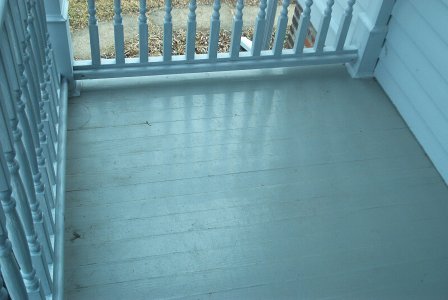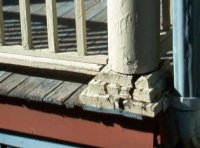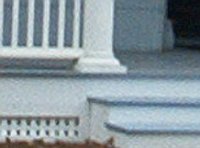













Restoration
Below you will find a few examples of
the old house restoration I've done, and the techniques and materials
used.
As a workaround, I used to use salvage yellow pine flooring for porch floors; the floors I replaced with salvage indoor flooring are still holding up great. However, it's a pain to clean up, and is increasingly scarce. In recent years, I have been using a new product, green treated tongue-in-groove flooring. This is a much higher grade of lumber than most treated wood (but still affordable), can (and must be) painted immediately, looks just like the old stuff, and holds up great. It is kiln-dried after treatment, and so is bone dry when you buy it.

Painted exterior wood that needs to be replaced can always be made to
look like the original. Don't listen to anyone who tells you that "it
can't look the same as it did." The choice of
materials is critical; I usually use Western Red Cedar heartwood for
new components that will take a beating from the weather, such as these
post bases. A couple of the originals had been replaced with plain
square boards. I turned new ones to match the originals.


Porches
Porches are a common, prominent feature of older homes, and really take a beating from the weather. Early 20th century porch floors in this region were typically made of tongue-in-groove yellow pine or fir flooring. When old-growth lumber was available, this was a fine choice of lumber for exterior flooring; however, today's untreated t&g does not hold up well on porch floors.As a workaround, I used to use salvage yellow pine flooring for porch floors; the floors I replaced with salvage indoor flooring are still holding up great. However, it's a pain to clean up, and is increasingly scarce. In recent years, I have been using a new product, green treated tongue-in-groove flooring. This is a much higher grade of lumber than most treated wood (but still affordable), can (and must be) painted immediately, looks just like the old stuff, and holds up great. It is kiln-dried after treatment, and so is bone dry when you buy it.



Restoration of wood
Some architectural components, like
porch posts, are quite expensive to reproduce, and are unlikely to be as durable
as the original. Many such components
are getting so old that the wood has degraded past the point where it
will hold paint for any length of time.
Wood in this condition will not hold paint, caulk, or wood filler:

Wood in this condition will not hold paint, caulk, or wood filler:

If something is not done to seal this
and get paint to bond, it will grow exponentially worse underneath the
new paint. To remedy this situation, the paint is removed, and a
penetrating epoxy sealer is applied. I use the best, manufactured by Smith and Co. This stuff
was developed for wooden boat repair, and stops the deterioration cold.
Furthermore, if a high quality oil-based primer is applied before
complete cure of the final epoxy coat, the primer forms a chemical bond
with the epoxy, resulting in extremely long-lasting protection.


Sometimes it seems like old house
components are just asking to take a beating from the weather. I
recently replaced these rakes, using the old ones as templates:


Clearly, just nailing up some #2 white pine
was not going to do! The degree of exposure is made
worse by the little boards on the front of the big ones. I used cedar,
and permanently bonded the rake parts together on the ground with
polyurethane glue. I put a heavy bead of Ultima (a very sticky,
durable, paintable sealant) at the critical joint between the top of the bottom
board and the main one, to prevent water penetration when the paint
fails. Prior to installation, the rakes were heavily primed with high
quality oil-based primer. Once installed, everything was caulked,
primed (again) and painted with the rest of the house.